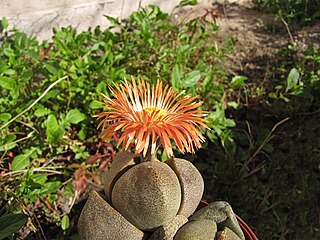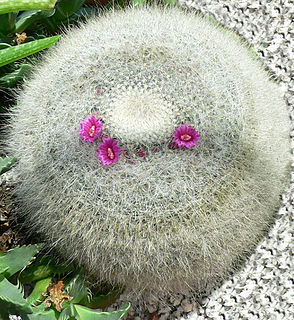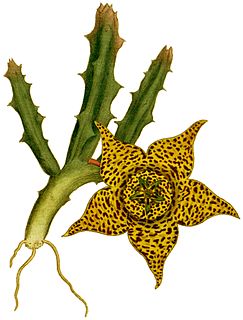
Opuntia microdasys is a species of flowering plant in the cactus family Cactaceae, native and endemic to central and northern Mexico.

Ferocactus glaucescens, the glaucous barrel cactus, is a species of flowering plant in the family Cactaceae, native to the limestone hills of Hidalgo, endemic to México. It is a spherical or cylindrical cactus growing to 60 cm (24 in) in diameter, with long yellow spines and yellow flowers in summer.

Ferocactus viridescens is a species of flowering plant in the cactus family Cactaceae. This rare barrel cactus is known by several common names, including coast barrel cactus, keg cactus and San Diego barrel cactus. Most of its native range is in San Diego County, California, where it is threatened by development, agriculture, and other alterations in its habitat. It is also found in northern Baja California, Mexico.

Mammillaria rhodantha, the rainbow pincushion, is a plant in the cactus family (Cactaceae) and is one of 171 species in the genus Mammillaria which are characterized by having nipple-shaped tubercles or prominences on their surface.

Mammillaria elongata, the gold lace cactus or ladyfinger cactus, is a species of flowering plant in the family Cactaceae, native to central Mexico. Growing to 15 cm (6 in) tall by 30 cm (12 in) wide, it consists of densely packed clusters of elongated oval stems, covered in harmless yellow or brown spines, and in spring producing white or yellow flowers. It is among the commonest and most variable of its genus in nature, and is a popular subject for cultivation. It has gained the Royal Horticultural Society's Award of Garden Merit.

Mammillaria spinosissima, also known as the spiny pincushion cactus, is a species of flowering plant in the cactus family Cactaceae, endemic to the central Mexican states of Guerrero and Morelos, where they grow at elevations of approximately 1,600 to 1,900 metres. The species was described in 1838 by James Forbes, gardener of the Duke of Bedford. Botanist David Hunt collected a specimen in 1971, when he located one near Sierra de Tepoztlan, Mexico.

Parodia magnifica is a species of flowering plant in the cactus family Cactaceae, native to southern Brazil. One of several species called ball cactus, it grows to 7–15 cm (3–6 in) tall by 45 cm (18 in) broad, with heavily ribbed, spherical to columnar, spiny and hairy stems, bearing pale yellow flowers in summer. Its natural habitat is cool, dry temperate grassland at elevations of up to 800 m (2,600 ft). Populations are sparse and fragmented, and it has been designated as “Endangered” by the IUCN Red List.

Pleiospilos nelii is a species of flowering plant in the family Aizoaceae, native to South Africa. It grows in semi-arid areas with rainfall of between 150mm and 300mm, in the Karoo of South Africa.

Mammillaria magnimamma, common name Mexican pincushion, is a species of flowering plant in the cactus family Cactaceae.

Echinocereus subinermis is a species of flowering plant in the cactus family Cactaceae, native to north, northwestern, and central Mexico. The stem is a ball with 5 to 8 prominent ribs, growing to a cylinder or cone 30 cm (12 in) tall and wide, and producing yellow flowers 8 cm (3 in) long in early summer.

Mammillaria bombycina, the silken pincushion cactus, is a species of flowering plant in the family Cactaceae.

Mammillaria geminispina, the twin spined cactus, is a species of flowering plant in the family Cactaceae, native to central Mexico. It grows to 25 cm (10 in) tall by 50 cm (20 in) broad. The clustering spherical stems, 8 cm in diameter, are covered in white down and white spines. Carmine pink flowers are borne in summer and autumn.

Mammillaria hahniana, the old lady cactus, is a species of flowering plant in the family Cactaceae, native to central Mexico. It grows to 25 cm (10 in) tall by 50 cm (20 in) broad. The solitary spherical stems, 12 cm in diameter, are covered in white down and white spines. Reddish purple flowers are borne in spring and summer, sometimes forming a complete ring around the apex of the plant.

Mammillaria plumosa, the feather cactus, is a species of flowering plant in the family Cactaceae, native to Northeastern Mexico.

Parodia scopa, the silver ball cactus, is a species of flowering plant in the cactus family Cactaceae, native to upland southern Brazil and Uruguay. It is a ball- or cylinder-shaped cactus growing to 5–50 cm (2–20 in) tall by 10 cm (4 in) broad, with a spiny, woolly crown and pale yellow flowers in summer.

Mammillaria bocasana is a species of cactus in the subfamily Cactoideae. It is often sold as a "powder puff" cactus, and also as a "Powder Puff Pincushion." The plant is protected from collecting in the wild in Mexico.

Gymnocalycium baldianum, the spider-cactus or dwarf chin cactus, is a species of flowering plant in the cactus family Cactaceae, native to the Catamarca Province in Argentina.

Orbea variegata is a species of flowering plant in the family Apocynaceae, known as the star flower. It is native to the coastal belt of the Western Cape, South Africa, growing actively during the winter rainfall season. It is an invasive species in southern Australia.

Mammillaria surculosa is a species of flowering plant in the cactus family Cactaceae, native to north eastern Mexico, where it occurs in extremely isolated patches at altitudes of 950–1,200 m (3,120–3,940 ft). It is registered as “Endangered” by the IUCN Red List. Growing to 10 cm (3.9 in) tall by 50 cm (20 in) wide, this tiny plant forms colonies of spiny stems with relatively large, lemon yellow flowers in spring.

Mammillaria sphaerica, the longmamma nipple cactus or pale mammillaria is a species of flowering plant in the cactus family Cactaceae, native to south eastern Texas in the USA and north eastern Mexico, where it occurs in scattered patches at altitudes up to 1,000 m (3,300 ft). It forms clumps of small pale green spheres to 5 cm (2.0 in) in diameter, with short hairs and pale yellow flowers up to 3 cm (1.2 in) wide in summer.





















